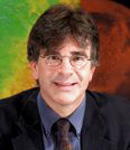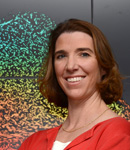GRAA NEWSLETTER
P.O. Box 1184, Greenbelt, MD 20768-1184
IMPORTANT DATES
| June 14 |
 Dr. James Garvin, NASA's Goddard Space Flight Center
Chief Scientist, will talk about Goddard’s exciting new planetary
mission: “Sounding the Venus Atmosphere with DAVINCI” the Deep
Atmosphere Venus Investigation of Noble gases, Chemistry, and Imaging mission.
Dr. James Garvin, NASA's Goddard Space Flight Center
Chief Scientist, will talk about Goddard’s exciting new planetary
mission: “Sounding the Venus Atmosphere with DAVINCI” the Deep
Atmosphere Venus Investigation of Noble gases, Chemistry, and Imaging mission.
|
| July 12 |
 Lori Perkins of Goddard’s Science Visualization Studio will give
an encore performance of her talk, “Visualizing NASA’s Science
Results and Why it Matters”. We were unable to show the spectacular videos
produced by SVS due to equipment problems in Lori’s talk last year,
so we have invited her back. These big-screen dramatic videos make
many of our hard-won scientific findings available to scientists and
the public around the world.
Lori Perkins of Goddard’s Science Visualization Studio will give
an encore performance of her talk, “Visualizing NASA’s Science
Results and Why it Matters”. We were unable to show the spectacular videos
produced by SVS due to equipment problems in Lori’s talk last year,
so we have invited her back. These big-screen dramatic videos make
many of our hard-won scientific findings available to scientists and
the public around the world.
|
|
PLEASE MAKE RESERVATIONS BY THURSDAY, MAY 9th!
We need an accurate count of the number of members planning to attend each
luncheon. Please make your reservation at
graalunch@gmail.com
(preferred), or call (240) 720-7833. GRAA is following the PG County and
American Legion Hall Covid19 protocol.
|
COMMENTS FROM TONY COMBERIATE AND ARLIN KRUEGER:
Our May luncheon speaker was Dr. Michelle Thaller, Astrophysicist,
and Assistant Director of Science for Communications at Goddard.
Her talk entitled “The James Webb Space Telescope: New Eyes on the
Universe,” described the capability and expectations of NASA’s
latest great observatory, first selected for development in 1995 and
launched on Christmas Day, December 25th, 2021. She explained that Webb
operates at infrared (IR) wavelengths that can’t be seen from the
ground. In addition, visible-light astronomy now takes advantage of new
ground-based telescope technology that corrects atmospheric distortion and
has effective apertures the size of the Earth. Webb is designed to look at
stars and galaxies in the early universe. We have to look in the IR to see
them because stellar wavelengths are red-shifted when they reach the Earth
some 14 billion years later. The first stars collapsed as the original
hydrogen burned out during fusion, leading to dust-forming explosions.
This dust clouds the view in visible wavelengths, but IR light penetrates
the dust to reveal the stars in galaxies. In earlier IR missions even
our closest galaxy, Andromeda, appears fuzzy due to small telescope
apertures. This will be resolved by the 7.5m diameter Webb mirror.
Unlike Hubble, Webb does not have a protective shroud around the mirrors.
However, its detectors operate near absolute zero and depend on a sun
shield to protect from solar heating. The shield operates at a hot
sun-side temperature of 185 degrees F and a cold space-side (detector)
temperature of -388 degrees F.
Michelle showed impressive videos of Webb’s development and test
program both at Goddard and Northrop Grumman before it was shipped (by
boat) 5,800 miles from California to its launch site in French Guiana.
Webb is an engineering marvel! The mirror assembly and the sun shield
are folded to fit the nose fairing of the rocket. The shield itself
contains 140 release mechanisms, 70 hinge assemblies, 8 deployment motors,
400 pulleys, and 1,312 feet of cable along with supporting bearings,
springs, and gears. A single-point failure nightmare!
Webb had a picture-perfect launch on an Ariane 5 rocket that saved
Webb’s fuel to extend its life. The solar array deployment was seen
in a video from the booster. Then in the month-long trip to orbit at
the second Lagrange point, L2, a flawless deployment of its sun shield
and mirror took place. Unfolding the five-layer, tennis court-sized
heat shield was the riskiest element. Following that the mirror wings
were unfolded and each of the 18 mirror segments was individually aligned
to a common focal point. The first photo showed 18 separate images of a
star from the mirror segments before they were aligned. In an extensive
commissioning process, even the curvature of each segment was adjusted
for optimum phasing. Meanwhile, the instruments are being calibrated
while the detectors cool to near-zero K operating temperatures.
Areas of Webb science utilizing its four instruments and a coronagraph
include giant black holes (a billion times the mass of our sun); the
life cycle of stars; planetary systems, and exoplanets. The images,
available later this year, will likely be as revolutionary as from
its predecessor Hubble three decades ago. Follow the mission at the
jwst.nasa.gov website.
REMEMBERING OUR FORMER COLLEAGUES:
Penshu Yeh,
70, of Rockville, MD, died on January 21, 2022. She received a Master of
Science in electrical engineering from the University of Washington and
a Ph.D. in electrical engineering from Stanford University and worked in
both academia and industry researching computer/robotic vision, pattern
recognition, and data compression prior to joining NASA in 1988. In the
1990s, she assisted the development of the first Consultative Committee
for Space Data Systems (CCSDS) lossless data compression standard. She
was a co-investigator on the data compression experiment for the Small
Satellite Technology Initiative (SSTI) Lewis spacecraft in 1997 and
worked with engineers at the University of Idaho's Center for Advanced
Microelectronics Biomolecular Research (CAMBR) on the development of
special data compression processors for the Landsat Data Continuity
Mission (LDCM) and for the Goddard-developed Fast Plasma Investigation
(FPI) instrument for the Magnetospheric Multiscale Mission (MMS).
She also developed data compression methods that improved the processing
of data for other missions, including the Hubble Space Telescope (HST),
and was a co-author on numerous published articles and papers.
Dorothy Karen Moy,
72, of Clifton, VA died on April 15, 2022. She was a graduate of
the University of Maryland and High Point High School in Beltsville,
Maryland. She developed a passion for the space program early in her life
and during her career at Goddard she worked on unmanned programs. She
also sewed professionally from the day she married—this year would
have been her 45th wedding anniversary—and used her business acumen
to start a business, "Karen's - A Personal Touch," continuing to sew
throughout the rest of her life.
Epaminondas G. Stassinopoulos,
also known as “Stass,” died at the age of 101 on May 16, 2022. He
was born in Bonn Germany and grew up in Berlin where he was a student at
Berlin's Academische Gymnasium in 1935 when members of the Hitler-Jugend
(Hitler Youth) assaulted him and his brother leaving both seriously
injured. The family then fled to Greece to escape Nazism. He studied
law in Athens and, when Axis Powers occupied Greece in 1941, he served
as a member of the Greek resistance movement. He also served in the 1st
Infantry Division during the Greek Civil War from 1946-1949, alongside US
advisors under the Marshall Plan one of whom sponsored his emigration to
the U.S. in 1954. Inspired by America’s aerospace program, he decided
to study physics at American and Catholic Universities in Washington
D.C. In 1961, he went to work for NASA at GSFC where he became Head
of Goddard SFC's Radiation Physics Office, worked on research in
magnetospheric physics, geomagnetism, solar-terrestrial relationships,
natural and man-made radiation exposure, radiation effects on biological
and electronic systems and components, and radiation environment modeling.
He was the principal investigator in multiple original research for
NASA and the author or co-author of hundreds of papers and articles
in peer-reviewed scientific journals and books in the field of space
radiation. He was awarded a patent in 2008 for his miniaturized radiation
spectrometer, currently on the NASA Deep Space Climate Observatory
(DSCOVR) satellite, which was launched in 2015. At 95 years of age, he
co-authored a NASA Technical Report "Forty-Year 'Drift' and Change of the
South Atlantic Anomaly (SAA)", making him one of the oldest publishing
research scientists in NASA's history. On May 27, he was interred in
Parklawn Memorial Cemetery in Rockville next to his wife of 63 years,
Eftichia, who was a philologist and archaeologist.
Robert O. Wales,
100, passed away May 28, 2022 at Buckingham’ s Choice in Adamstown,
MD just 6 weeks from his 101st birthday; he was born July 14, 1921
in Washington D.C. and graduated from Woodrow Wilson High School
in 1938 and then began undergraduate studies at George Washington
University (GWU). His studies were interrupted by World War II when,
as a member of the D.C. National Guard Band, he was called to service
in the U.S. Army in January 1941 serving for the duration of the war.
He completed his degree from GWU in 1947 and days later married Ruth
Hale of Blackstone VA. They raised their family in Colesville, MD. For
45 years, Bob was an electronic engineer for the federal government
spending 28 of those years at Goddard where he was at the forefront of
computer and data technology serving in the Engineering Directorate’s
Instrument branch where he supported the ACTS Project in the 1970s and
was the Project Operations Director for ATS/ICE/IMP and ISEE 1&2 in the
1980s. Bob moved to Middletown, MD in 1989, where he again began playing
his euphonium horn, marching in parades and riding on bandwagons into
his 90s with the Harmony, Browningsville, and Rohrsville Cornet Bands and
the Yellow Springs Concert Band. Active travelers, Bob and Ruth enjoyed
many walking adventures throughout the U.S. and the world. He was also a
lifelong Baltimore Orioles baseball fan and enjoyed watching their games,
current and past, until his last day.
FROM THE GODDARD ARCHIVES — IT HAPPENED
IN JUNE:
Forty years ago, on June 27, 1982 Shuttle Columbia STS-4 carried the first Get
Away Special (GAS) experiment.
TREASURER’S REPORT:
Treasurer Jackie Gasch received tax-deductible donations from Ralph Welsh,
Karl Peters and Belle Davis in memory of Alberta Moran.
 Dr. James Garvin, NASA's Goddard Space Flight Center
Chief Scientist, will talk about Goddard’s exciting new planetary
mission: “Sounding the Venus Atmosphere with DAVINCI” the Deep
Atmosphere Venus Investigation of Noble gases, Chemistry, and Imaging mission.
Dr. James Garvin, NASA's Goddard Space Flight Center
Chief Scientist, will talk about Goddard’s exciting new planetary
mission: “Sounding the Venus Atmosphere with DAVINCI” the Deep
Atmosphere Venus Investigation of Noble gases, Chemistry, and Imaging mission.
 Lori Perkins of Goddard’s Science Visualization Studio will give
an encore performance of her talk, “Visualizing NASA’s Science
Results and Why it Matters”. We were unable to show the spectacular videos
produced by SVS due to equipment problems in Lori’s talk last year,
so we have invited her back. These big-screen dramatic videos make
many of our hard-won scientific findings available to scientists and
the public around the world.
Lori Perkins of Goddard’s Science Visualization Studio will give
an encore performance of her talk, “Visualizing NASA’s Science
Results and Why it Matters”. We were unable to show the spectacular videos
produced by SVS due to equipment problems in Lori’s talk last year,
so we have invited her back. These big-screen dramatic videos make
many of our hard-won scientific findings available to scientists and
the public around the world.